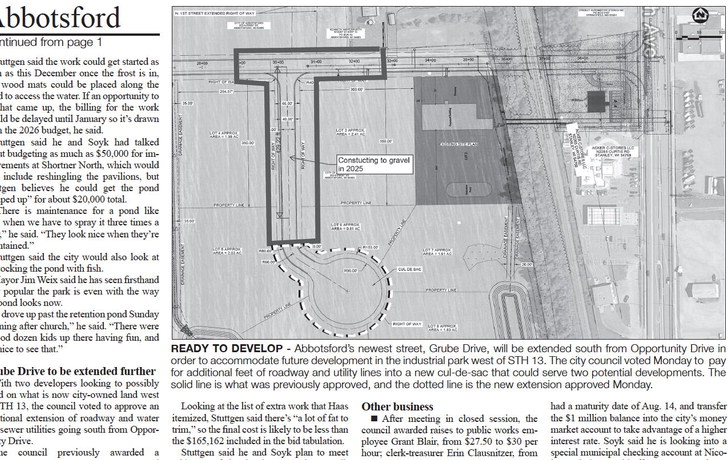Abbotsford approves updated comp plan
Without much fanfare or any contentious debates, the Abbotsford City Council approved a new 230-page comprehensive plan on Monday that offers updated details on the city’s demographics and infrastructure and outlines its general goals for the next 20 years.
Monday’s approval by the council, following a required public hearing by the planning commission, capped off a months-long process to update a plan that was first adopted in 2005. The update was completed by staff at West Central Wisconsin Regional Planning Commission (WCWRPC), who were hired last year after the city received a $14,550 grant to write a new plan.
Under state law, “any program or action of a local government which regulates land use (e.g., zoning, subdivision regulations, agricultural preservation programs) must be consistent with that government’s comprehensive plan.” If an exception is needed, the city must grant a conditional-use permit.
The process of updating the comp plan involved multiple meetings between the planning commission and Chris Straight, senior planner at WCWRPC, along with a 23-question community survey posted online last summer and focus group meetings to address the city’s housing issues.
Besides housing, questions regarding local railroad service and downtown development dominated some of the discussions.
When it comes to the unused rail line running north to Medford and south to Spencer, the comp plan’s Transportation section includes the following statement regarding the planning commission’s perspective on the future potential of rail service in Abbotsford: “The commission supports the re-use of the rail line for economic development pur- poses but is skeptical whether renovation for rail service is cost feasible. Based on past conversations with city businesses, there is no clear demand for rail service within the community. The city remains open to considering reviving the line for freight rail or repurposing the corridor as a rails-to-trail initiative.”
On the issue of downtown development, the plan’s Economic Development section says the city’s downtown “will continue to offer a mix of retail and service businesses in a pedestrian-friendly setting.” However, the plan also notes that “many downtowns are no longer required to provide every good or service for the entire community. Many downtowns now have less general retail and more specialized services or niche retail.”
Abbotsford’s downtown has seen some revitalization mostly due to Hispanic-owned businesses, but a lack of parking on First Street is still a concern, as is the dilapidated nature of some older buildings. The city had planned to renovate the sidewalks and roadway on First Street sometime this decade, but that project has been pushed back to 2030.
With the city’s population growing steadily – and projected to continue growing into the future – demand for affordable housing continues to rise, even after the construction of 10 new apartment buildings on the city’s northwest corner. As the city’s share of owner-occupied housing decreases and the numbers of renters increases, many residents are looking to maximize their rental space by squeezing more people into smaller units, according to the Population and Housing section.
“About 46% of renters in the City of Abbotsford spent more than 30% of their income on housing costs (rent, insurance, utilities) in 2023 and were considered costburdened,” the plan states.
Also, as the population gets older, the city will need to look for more senior housing opportunities so residents can “age in place” instead of having to move elsewhere, the plan states.
The plan’s two Population and Housing goals include ensuring “an adequate housing supply” that meets the needs of all income levels and ages and offering a “safe, wellmaintained housing stock” with new housing developments that are “compatible with its neighborhood context and the character of the city.”
Now that an updated plan has been adopted, city administrator Josh Soyk said the plan does not need to be rewritten again for another 10 years, but the council can always revisit it and make revisions before then.
“If you want to review this thing every year or every other year, we can certainly do that too,” Soyk told the council before it voted unanimously to approve the plan. “You have to update it every 10 years, but there’s nothing that says you can’t look at it sooner.”


